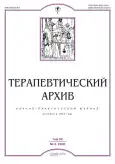Comparison of myocardial contrast stress-echocardiography and standard stress-echocardiography in detecting myocardial ischemia in patients with different severity of coronary artery stenoses
- Authors: Atabaeva L.S.1, Saidova M.A.1, Shitov V.N.1, Staroverov I.I.1
-
Affiliations:
- Myasnikov Insitute of Clinical Cardiology, National Medical Research Center for Cardiology
- Issue: Vol 92, No 4 (2020)
- Pages: 45-50
- Section: Original articles
- URL: https://journals.rcsi.science/0040-3660/article/view/34096
- DOI: https://doi.org/10.26442/00403660.2020.04.000506
- ID: 34096
Cite item
Full Text
Abstract
Aim. To compare diagnostic value between standard stress-echocardiography and myocardial contrast stress echocardiography in detection of myocardial ischemia in patients with different severity of coronary artery stenoses.
Materials and methods. Myocardial contrast stress-echocardiography and standard stress-echocardiography were performed in 38 patients with coronary artery stenoses over 50% by angiography. Of all lesions 39 were intermediate (50–75%) and 33 – over 75% stenoses. Fractional flow reserve (FFR) was measured in 12 coronary arteries. During myocardial contrast stress-echocardiography wall motion and myocardial perfusion was assessed.
Results. Adequate visualisation increased from 81.6% in unenhanced segments to 96.1% in contrast-enhanced segments. The sensitivity, specificity, and diagnostic accuracy of standard stress-echocardiography and myocardial contrast stress-echocardiography in intermediate (50–75%) coronary stenoses were 44%, 83%, 56% and 56%, 94% и 64% respectively compare to angiography. Taking into account the 12 arteries with evaluated FFR, these parameters increased to 52%, 93% и 65% in standard stress-echocardiography and to 68%, 100% and 75% in myocardial contrast stress-echocardiography. In coronary stenoses over 75% the sensitivity, specificity, and diagnostic accuracy of standard stress-echocardiography and myocardial contrast stress-echocardiography were 78%, 88%, 80% and 86%, 100%, 92% respectively
Conclusion. Use of contrast-enhanced stress-echorardiography significantly increased the diagnostic value of this method by improving endocardial border visualization and possibilities of myocardial perfusion assessment.
Full Text
##article.viewOnOriginalSite##About the authors
L. S. Atabaeva
Myasnikov Insitute of Clinical Cardiology, National Medical Research Center for Cardiology
Author for correspondence.
Email: atabaeva_lina@mail.ru
ORCID iD: 0000-0003-1911-1256
врач функциональной диагностики, аспирант отд. ультразвуковых методов исследования
Russian Federation, MoscowM. A. Saidova
Myasnikov Insitute of Clinical Cardiology, National Medical Research Center for Cardiology
Email: atabaeva_lina@mail.ru
ORCID iD: 0000-0002-3233-1862
д.м.н., проф., рук. отд. ультразвуковых методов исследования
Russian Federation, MoscowV. N. Shitov
Myasnikov Insitute of Clinical Cardiology, National Medical Research Center for Cardiology
Email: atabaeva_lina@mail.ru
мл. науч. сотр. отд. ультразвуковых методов исследования
Russian Federation, MoscowI. I. Staroverov
Myasnikov Insitute of Clinical Cardiology, National Medical Research Center for Cardiology
Email: atabaeva_lina@mail.ru
д.м.н., проф., рук. отд. неотложной кардиологии
Russian Federation, MoscowReferences
- Boytsov SА, Zayratiants ОV, et al. Comparison of coronary heart disease mortality in men and woman age 50 years and older in Russia and USA. Russ J Cardiol. 2017;6(146):100-7.
- Popma JJ, Chan S. Cardiac Catheterization and Percutaneous Coronary Intervention. In: Cannon CP, O’Gara PT (eds). Critical Pathways in Cardiology. Philadephia (PA): Lippincott Williams & Wilkins. 2001:142-7.
- Zamorano JL, Achenbach S, et al. The Task Force on the management of stable coronary artery disease of the European Society of Cardiology. Eur Heart J. 2013;34:2949-3003.
- Porter TR, et al. Guidelines for the Cardiac Sonographer in the Performance of Contrast Echocardiography: A Focused Update from the American Society of Echocardiography. J Am Soc Echocardiogr. 2014;27(8):797-810.
- Porter TR, Mulvagh ShL, et al. Clinical Applications of Ultrasonic Enhancing Agents in Echocardiography: 2018 American Society of Echocardiography Guidelines Update. J Am Soc Echocardiogr. 2018;31(3): 241-74.
- Senior R, Moreo A, Gaibazzi N, et al. Comparison of sulfur hexafluoride microbubble (SonoVue)-enhanced myocardial echocardiography to gated single photon emission computerized tomography for the detection of significant coronary artery disease: a large European multicenter study. J Am Coll Cardiol. 2013;62:1353-61.
- Picano E. Stress Echocardiography. Sixth Edition. CNR Pisa Ist. Fisiologia Clinica. Italy, 2015.
- Verma B, Singh A. Comparison of Contrast Enhanced Low-Dose Dobutamine Stress Echocardiography with 99mTc-Sestamibi Single-Photon Emission Computed Tomography in Assessment of Myocardial Viability. Open Access Maced J Med Sci. 2019;7(8):1287-92.
- Porter TR, Smith LM, Wu J, et al. Patient outcome following 2 different stress imaging approaches. J Am Coll Cardiol. 2013;61:2246-455.
- Shah BN, Balaji G, Alhajiri A, et al. Incremental diagnostic and prognostic value of contemporary stress echocardiography in a chest pain unit: mortality and morbidity outcomes from a real-world setting. Circ Cardiovasc Imaging. 2013;6:202-9.
- Thomas D, Xie F, Smith LM, et al. Prospective randomized comparison of conventional stress echocardiography and real time perfusion stress echocardiography in detecting significant coronary artery disease. J Am Soc Echocardiogr. 2012;25:1207-14.
- Plana JC, Mikati IA, Dokainish H, et al. A randomized cross-over study for evaluation of the effect of image optimization with contrast on the diagnostic accuracy of dobutamine echocardiography in coronary artery disease: the OPTIMIZE trial. JACC Cardiovasc Imaging. 2008;1: 145-52.
- Arnold JR, Karamitsos TD, Pegg TJ, et al. Adenosine stress myocardial contrast echocardiography for the detection of coronary artery disease: a comparison with coronary angiography and cardiac magnetic resonance. JACC Cardiovasc Imaging. 2010;3:934-43.
- Porter TR, Adolphson M, High RR, et al. Rapid detection of coronary artery stenoses with real-time perfusion echocardiography during regadenoson stress. Circ Cardiovasc Imaging. 2011;4:628-35.
- Gaibazzi N, Reverberi C, Lorenzoni V, et al. Prognostic value of high-dose dipyridamole stress myocardial contrast perfusion echocardiography. Circulation. 2012;126:1217-24.
- Miszalski-Jamka T, Kuntz-Hehner S, Schmidt H, et al. Myocardial contrast echocardiography enhances long-term prognostic value of supine bicycle stress two dimensional echocardiography. J Am Soc Echocardiogr. 2009;22:1220-7.
- Gaibazzi N, Porter T, Lorenzoni V, et al. Effect of Coronary Revascularization on the Prognostic Value of Stress Myocardial Contrast Wall Motion and Perfusion Imaging. J Am Heart Assoc. 2017;6(6). pii: e006202. doi: 10.1161/JAHA.117.006202
- Nihoyannopoulos P, Kisslo J. Echocardiography Second Edition. Springer International Publishing AG, part of Springer Nature 2018.
- Toth G, Hamilos M, Pyxaras S, et al. Evolving concepts of angiogram: fractional flow reserve discordances in 4000 coronary stenoses. Eur Heart J. 2014;35;2831-8.
- Tonino PAL, Fearon WF, et al. Angiographic versus functional severity of coronary artery stenoses in the FAME Study: Fractional Flow Reserve versus angiography in multivessel evaluation. J Am Coll Cardiol. 2010;55(25):2816-21.
Supplementary files













